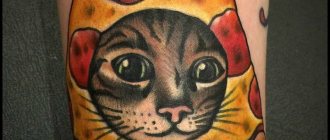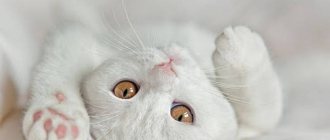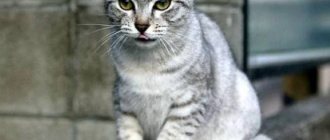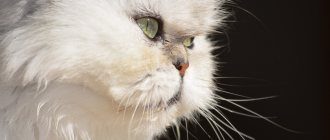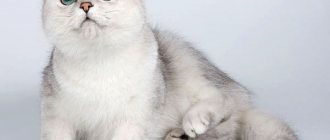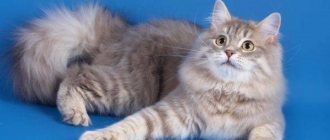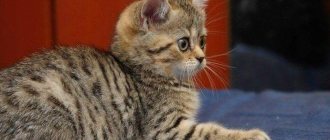Origin history and interesting facts
The French Chartreux is considered one of the oldest breeds bred in Europe. They are recognized throughout the world, except for Great Britain, where the Chartreux is considered a type of British Shorthair cat.
Due to the peculiar structure of the face, it seems that the cat is constantly smiling
The first mentions of these animals were in the 16th century. It is believed that the ancestors of cats came from the Middle East. Chartreuse cats are also known as Carthusian or medieval cats. Behind each of these names lies a separate version of the origin.
Based on the version of the Middle Ages, it is believed that in the 16th century Syrian pets with ashy fur and copper eyes were brought to Europe. Subsequently, the cats multiplied uncontrollably.
According to the second version, blue cats were bred on the territory of monasteries where members of the Carthusian order were located. One such area is the Grande Chartreuse Monastery.
Interesting! The French cat breed began to attract the interest of breeders only after the First World War. For the first time, Chartreux took part in the exhibition in 1928.
Monastery of Grande Chartreuse
Interesting facts about Carthusian cats
- During the Hundred Years' War between the French and British, these cats were used as food and their fur was used to make clothing.
- Chartreuse was the favorite cat of Charles de Gaulle himself, and now these blue cats live in the homes of famous politicians and artists in France.
- Kittens are born with blue eyes, which gradually turn gray and then take on their final color - orange or copper, without a single trace of green.
- The Carthusian cat rarely gives voice; its meow sounds faint, like that of a small kitten.
- In the Middle Ages in France, a mountain in the province of Savoy was named the Mountain of Gray Cats in honor of the Chartreuse. This name still sounds like this today.
Breed standards
Bombay cat - description of Bombay cats
The breed standard provides the following description:
- strong, muscular body;
- the hind legs are somewhat larger than the front legs;
- the head has the shape of an inverted trapezoid, large in size with round cheeks;
- the forehead is high, on top of the head there are wide, high ears;
- the neck is massive, but short;
- the wool is dense, shiny and soft;
- eyes large and round;
- eye color from yellow to dark orange;
- the tail is medium, flexible and mobile;
- The nose is gray.
Important! Toyger Korat and Chartreux are different breeds. They are often confused due to their similar coat color.
A sign of the breed is an even color without transitions or shadows
Chartreuse dimensions and weight
French cat up to 30 cm high at the withers. Weight depends on the sex of the cat. Males gain weight up to 7 kg, and females - from 4 to 5 kg.
Description of the Chartreuse breed: a cat with a respectable appearance
The breed is characterized by sexual dimorphism, that is, cats and cats differ significantly from each other in size and weight. Whiskered Monsieurs are usually classified as large animals, Madames - medium-sized. A cat usually weighs 4–5 kilograms, a Chartreux cat is a couple of kilograms heavier.
Body type
Envious people say that the Carthusian chartreuse looks like a potato on toothpicks due to its rather massive body on relatively slender legs. But in fact, this does not spoil the cat’s beauty at all, nor does it interfere with his strength and dexterity. The Chartreux cat breed is famous throughout the world for its mouse-catching talent!
Portrait
The Chartreux cat is a “solid” animal of solid build, with strong muscles and a broad chest. The head is rounded, but the full cheeks of adult cats (that same Cartesian hood) make it look like an oval. “Smart” high forehead and “smiling” muzzle. The eyes are round, large, attentive. The ears are straight, medium in size, and set high. The tail of the Chartreuse is medium-sized, flexible and mobile, as befits a successful hunter.
Special signs
The combination of only one acceptable color with one eye color is what distinguishes Chartreux cats. The description of the breed does not allow options: the color is blue (for non-felinologists - gray), the eyes are yellow, without the slightest admixture of green. Well, and the famous French cheeks - where would we be without them!
Voice
The Chartreuse's quiet voice contrasts with his solid appearance. These cats meow so quietly and rarely that especially suspicious owners worry whether their pet will be able to call for help in a moment of danger.
Wool
The coat of Chartreuse is short and thick, as they say, “stuffed”. Outwardly, cats seem plush, and to the touch their fur resembles otter fur to some, and sheepskin to others. In healthy animals it is shiny and silky.
Colors
If all cats are gray at night, then the Chartreux should always be gray and, most importantly, everywhere. Even the skin, nose and paw pads of these cats should be gray.
Character of the breed
The character of furry pets is calm, they react well to new people, and are clean. Over time, pets get used to other pets and easily get along together.
Lifestyle
Ocicat cat - description of the cat breed, red kitten
The French cat leads a measured life. He, like all cats, can sleep, play or go for a walk for hours. If a pet is bred to participate in exhibitions, then everyday life can be diluted with competitions. Thanks to their calm and calm nature, they can easily withstand exhibition events.
Interesting! The Chartreux cat rarely meows; he can only express his gratitude to his owner through a light purr.
Representatives of this breed love to hunt, so they will never miss the opportunity to chase a rodent or insect.
Relationship with the owner
The cats are very affectionate and friendly with their owners. They quickly get used to their society and try to spend as much time as possible in the company of people. Owners note the high intelligence of cats. They learn quickly, get used to their name and some commands. During the game, you can teach your pet to find and bring a toy.
The Chartreux cat is devoted to its owner. He unobtrusively follows a person and does not require affection or unnecessary attention.
Attachment to family
Chartreuses adhere to a special routine that they set for themselves. From the family they prefer to choose one person to whom they will give all their attention. However, even to their beloved owner, these cats do not always calmly give in and go into their arms. If the pet wants affection, he will come to the owner and let himself be petted.
Interesting! One of the Chartreuse's traits is jealousy. They show themselves as owners, so they can be jealous of the owner of other animals.
Attitude towards other animals
The Chartreuse breed is calm, so bringing other pets into the family is not prohibited. The cat treats unfamiliar animals normally and tolerantly. He tries to avoid conflict situations, but can stand up for himself if necessary. However, due to jealousy, Chartreux may feel uncomfortable if the owner pays more attention to another animal.
Relation to water
Washing these cats becomes a real challenge as they cannot tolerate water. Even the calmest and most resilient Chartreuse can begin to resist if water begins to pour on them. Due to the special density of the fur, it is quite difficult to wash a cat in a short time. Therefore, while bathing, it is necessary to hold the animal tightly and do everything as carefully as possible.
Walk
Chausie (cat): description of the breed F1, F2, F3, F4, F5
The Chartreux cat, the breed description of which is presented above, tolerates cold and humidity well. Therefore, you can walk with him in any weather. Due to the tendency to be overweight, walks in the fresh air should be daily. When outdoors, your pet must be wearing a special leash.
Important! In the summer, it is necessary to walk in the morning and evening so that direct sunlight does not fall on the cat's fur.
Features of care
The Carthusian cat is a short-haired cat.
It does not require special care, but during molting seasons it is recommended to spend more time with your pet. A furminator is suitable for this .
The issue of bathing requires special attention.
The peculiarity of this breed is that when carrying out water procedures, it is necessary to wait for some time until the water penetrates through the thick coat.
This cat's fur easily repels water due to its texture and thickness.
More information on how to wash a cat can be found here:
Purebred Chartreux always have yellow eyes.
It does not require grooming, but if you wish, you can pamper your pet with a change of image.
If you have the skills and capabilities, you can cut it yourself using a clipper .
A mandatory procedure is ear cleaning. It is recommended to do it once a week.
Bathe? Well, no: I’m all licked clean! Better scratch me, master!
Combing
Brushing should be regular, but not necessarily every day.
The animal will need special care during periods of molting.
Then you need to help remove the fallen hairs.
Walk
These pets love to sleep.
However, if you live in a country house with an adjacent garden or other area, Carthusian cats will be happy to stretch their paws and prove themselves to be excellent hunters.
It’s not for nothing that in the Middle Ages they were considered excellent mousecatchers.
Interesting! From prolonged exposure to the sun, the coat of Carthusians can change its color. It will have a dull brownish tint. Therefore, it is important to ensure that the animal is not exposed to direct sunlight too much.
Warm up before a walk
When living in an apartment, walking will still not be superfluous.
These blue couch potatoes will not mind the collar and company of their owner.
Hygiene procedures and appearance care
When caring for a purebred pet, it is necessary to carry out regular hygiene procedures. Ears are cleaned 1-2 times a week, depending on the degree of contamination. For cleaning, use cotton swabs pre-moistened in water. It is necessary to look after the eyes every day, as the breed often has discharge from the corners. Remove dirt with a soft damp cloth.
Nails need to be trimmed every 2-2.5 weeks. Teeth are brushed 3 times a week with a special paste for cats. Animals should be accustomed to such procedures from a young age.
The wool is periodically combed out. The regularity depends on the time of year and whether the animal sheds.
Important! To prevent pathologies, the cat should be regularly vaccinated and given anti-parasite medications.
Timely vaccination is the key to your pet’s health
Maintenance and care
Carthusian cats adapt well to any living conditions. They feel equally comfortable in an apartment and in the courtyard of a private house. They get used to their new place of residence very easily. The stress of moving is much easier to bear than most other breeds. The Carthusian cat loves to bask in the sun, but ultraviolet radiation causes its beautiful fur to fade and take on a brown tint.
In a Carthusian cat's house, you will definitely choose a favorite place, and it will not always be a bed provided by the owner. It’s difficult to say where this place will be, a chair or a shelf in a closet, but it will be almost impossible to keep the animal away from it. Cartesian cats really don't like closed doors. It is better to take this feature into account, and you should not be offended by the animal if it has to scratch the doors for a long time in an attempt to open them.
Carthusian kittens learn house rules very quickly. Trained by the breeder to go to the litter box, they almost immediately remember where it is in the new home, as well as the location of bowls with food.
Care
There is nothing difficult about caring for a Chartreuse. Cats shed quite a lot, but if you brush them once or twice a week, there will be practically no hair scattered around the house. There is no need to bathe often. Cats themselves do a good job of personal hygiene. Carthusians are usually given a full bath with shampoo before shows or at the end of the seasonal molting.
Ears are cleaned as needed. If wax and dirt do not accumulate in them, you shouldn’t poke into them with an ear stick, but it is advisable to trim the claws every 3-4 weeks. The claws are cut literally a few millimeters so that the cat does not cling to carpets and furniture. It is not recommended to trim its nails if your pet regularly goes outside. Many animals develop oral diseases in adulthood, so it is good to teach them to brush their teeth from an early age.
Diet
There are no special features in feeding Carthusian cats. The requirements are the same as for others. The diet can be natural or consist of ready-made food, wet or dry. In the first case, the main dish on the menu should be meat, frozen or boiled. The diet should also include fermented milk products, eggs, and fish. If the cat does not eat any fruits and vegetables, then you definitely need to sprout grass or give vitamin and mineral supplements. If the diet is based on complete ready-made feed, no additional feeding is required. Carthusian cats are prone to obesity, so it is better to give them food in portions, adhering to a schedule.
Health and feeding of Chartreuse cats
Chartreuse kittens and adult cats are predisposed to a number of diseases. The main pathologies include dysplasia and luxation of the patella. Monitoring his condition will help determine if a cat has problems with his bones. When dislocated, the animal hides and behaves passively.
The main cat doctor for the Chartreux is the dentist. In some representatives, the incisors grow small and closely set. To facilitate the growth of permanent teeth, primary incisors must be removed in time.
A common disease is gingivitis. It develops due to plaque that accumulates in the mouth. It is necessary to brush your pet's teeth regularly, and also visit a doctor once every six months.
Obesity is also a common problem. If you are overweight, your cat may develop problems with the heart and blood vessels.
The main product in the diet should be poultry and rabbit meat. You can use offal: kidneys, liver, heart. Before serving to the animal, food should be boiled to remove the risk of parasites. All dairy products are used. Eggs are used as a source of protein. 5% of the diet should be boiled vegetables.
Important! It is not advisable to include grains or starch in your food.
Prohibited products:
- chocolate and other sweet products;
- coffee;
- tea;
- onions, garlic, spices.
It is necessary to provide the cat with constant access to water. Dry food can be used in the daily diet. This type of food is good for your teeth and helps keep them clean.
Health
Often, cats of this breed are in quite good health.
An additional guarantee of this will be a balanced diet, compliance with care recommendations, as well as regular visits to the veterinarian.
Characteristic diseases
Like most purebred pets, Chartreuse has its weaknesses.
In particular, they are characterized by joint diseases: hip dysplasia, patella dislocations, etc.
If a dislocation is still quite easy to determine (the animal will “cry” and hide in a secluded place), then with dysplasia things are more complicated.
It can only be diagnosed using x-rays.
An equally problematic area is the oral cavity, or rather the teeth.
It is recommended to visit a cat dentist regularly to remove plaque, as well as to solve problems with the incisors.
The latter are small in size and closely spaced, therefore, to prevent permanent teeth from pushing them out, they must be removed in time.
Vaccinations
The vaccination schedule for Chartreuse is no different from that for other cats.
Babies need comprehensive vaccinations at the age of three months.
After this, a trip to the veterinarian for vaccinations is done once a year.
A mandatory procedure before vaccination is anthelmintic.
Reproduction and lifespan
Chartreux are ready for the first mating at the age of 1-1.5 years. Males mature a little later than cats. The main point before starting mating is choosing the right partner. Not only pedigree plays a role here, but also good health. The cat must be taken and left with the male for 2-3 days. During this time, copulations will occur, which guarantee the production of offspring.
Veterinarians indicate that pregnancy lasts about 65 days. A cat brings from 2 to 5 kittens.
The life expectancy of this breed is from 13 to 16 years.
Health and illness
The health status of the Carthusian cat breed is at a high level. There may be some diseases in adulthood and old age, for example, with the cardiovascular system, joints. At a young age, they rarely have any diseases, especially if you follow the requirements for the care and nutrition of the animal and adhere to the vaccination schedule. The average lifespan of a Chartreuse is 13-15 years.
Vaccinations and antiparasitic treatment
The kitten receives its first vaccinations while still in the nursery. They are placed at the age of 7 weeks, and then repeated again. The list of diseases that are dangerous for animals completely coincides with other cats.
Sterilization and castration
Sterilization of cats or male cats is carried out at the age of 6 – 8 months by a veterinarian. The procedure itself looks like a surgical operation, after which the animal needs rehabilitation and special care.
Advantages and disadvantages
This type of cat has a number of advantages and disadvantages that should be considered before purchasing a pet.
| Advantages | Flaws |
|
|
How to choose a kitten
There are no official nurseries for breeding Chartreux in Russia. Therefore, you will have to go abroad to get your pet. Due to the rarity of the breed, a kitten must be booked in advance, as there are many people who want to buy them.
Kittens of this breed are purchased at the age of 3 months. Since they are confused with the British, the first step is to study the breed standard.
The coat can only be in blue and light gray shades
